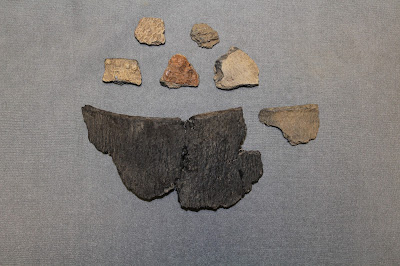The first incarnation of the State Museum of Pennsylvania
was located in the Executive office building (now the Ryan Building) attached
to the State Capitol. Due to limited expeditions by the museum, this first archaeology
gallery contained items primarily donated from local collectors. Subsequent excavations
sponsored by the Pennsylvania Historical Commission (now the Pennsylvania
Historical and Museum Commission) were some of the first to produce provenienced
collections that offered reliable insight into the lives of Pennsylvania’s
prehistoric inhabitants.
Using information gathered from 1931 excavations at the
Schultz site and historical accounts of other Susquehannock and Iroquoian village
sites, museum preparators Linneaus G. Duncan and Charles Andes crafted the display
we now know as the Schultz site diorama. The wax figures stand approximately 6
inches tall and were created from plaster molds. Once extracted from the mold,
the models were posed and details such as clothing, hair, and color were
meticulously added by Mr. Duncan, the museum’s chief preparator. In the
photograph below, Linneaus Duncan sculpts one of the figures, note the plaster mold
in the foreground with figures in varying degrees of completion arranged behind
it.
(Photo: PHMC Collections)
Oil paints were used to add color, and small pieces of
leather and fur were used for clothing. Often overlooked details of this
display are the miniature deer skins - one is tacked to the exterior of the
structure and another is draped across a log. Upon closer inspection, these tiny
pelts are revealed to be the furs of mice. Among the materials used by the preparators during the time
of the diorama’s construction were various chemicals, oils, shellac, varnish, various
paints, plasteline clay, beeswax (likely the material used to make the
figures), and assorted brushes and tools. These items were indicated on a
supply list dated 1932.
Linneaus Duncan (right) and Charles
Andes (left) prepare the area outside the stockade village
(Photo: PHMC Collections)
Completed by 1933, the Schultz site diorama was intended to
give museum visitors a view into prehistoric life that left no detail to the
imagination. The craftsmanship and care taken in the display’s creation is
still evident today. In the 1960s, the diorama was deemed “too good not to
use”, and was moved to its current location for the opening of the William Penn
Memorial Museum (now the State Museum of Pennsylvania) in 1965.
The Schultz site diorama in its
original location at the old State Museum
(Photo: PHMC Collections)
ABOUT THE SCHULTZ SITE
Since the 1930s, our knowledge of the Susquehannock culture
has expanded considerably. The Schultz site (36La7) was a mid to late 16th
century Susquehannock village located in Lancaster County. The first
excavations at this site were executed by Donald Cadzow in 1931 and were
sponsored by the Pennsylvania Historical Commission. These excavations yielded,
among other things, ornamental objects and pottery from features. Subsequent
excavations in 1969 revealed extensive detail about the Susquehannock culture
of the 16th century. Among the records from the latter excavation
are maps of excavations revealing the stockade and the shape and layout of
house structures. Contrary to the diorama, house structures were often rounded
at the ends, as opposed to squared. In
addition, we do not really know the height of the stockade or if it held a
firing platform. Finally, we now know that the Susquehannocks buried their dead
in cemeteries and not mounds as depicted on the far right of the diorama. Susquehannocks
occupied village sites in the Susquehanna River valley (shown in the diorama’s
background) in central Pennsylvania from the 16th century to the
time of European contact.
(Photo: Don Giles, State Museum of
Pennsylvania)





















